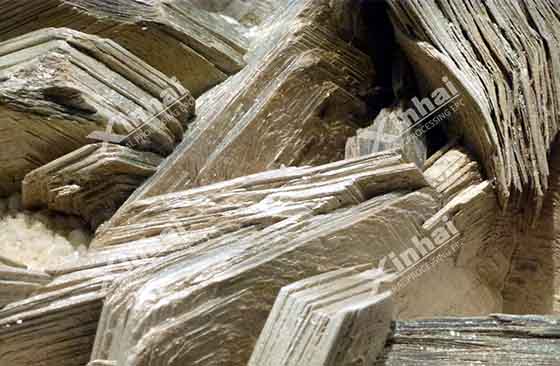

Warm Tip: If you want to know more details about equipment, solutions, etc, please click the button below for free consultation, or leave your requirements!
Mica is a rock-forming mineral with a hexagonal flaky crystal shape. It is widely used in coating, paint, electrical insulation and other industries.
At present, for synthetic mica with a crystal contour area greater than 4cm2, the separation is mainly based on the difference in shape and friction between the mica crystal and the gangue. Commonly used beneficiation methods include hand separation, friction separation and shape separation. For fragmental mica with a crystal contour area less than 4cm2, the separation is mainly based on the difference of physical and chemical properties of mica and gangue surface. Commonly used extraction methods are flotation and winnowing.

Workers pick the mica that has been separated into individual on the mine face or on the ore piles. Break the coenobium of mica and gangue with a hammer, and then select the mica. The advantages of manual selection are simple operation, no complicated equipment, and unlimited working conditions. The disadvantages of manual selection are high labor intensity, poor working conditions and low production efficiency. Some raw mica is difficult to be recovered due to the limited manual selection conditions, which affects the recovery rate of mica.
The principle of friction separation is based on the difference of rolling friction coefficient between synthetic mica and gangue. There are many equipment for friction beneficiation, including metal inclined plate separator, spiral concentrator, inclined plate separator with deflector, and inclined plate separator with "mound-shaped" plate. The feed particle size of this kind of separation machine is 20-70mm, the production capacity is 72-225m3/d, and the mica recovery rate is 85-95%.
At present, the friction beneficiation technology and equipment are not complete, so this method has not been widely used in mica beneficiation.
The essence of shape beneficiation is that mica crystals are flake, so they can fall into narrow cracks, while gangue particles are irregular block, so only cuttings with a particle size less than the width of the cracks can fall into narrow cracks with mica. Since mica and gangue have different difficulty in passing through the sieve, the purpose of separation can be achieved.
When separation, the sieve with more than two layers with different sieve surface structures will be used. Generally, the first layer of screen is strip-shaped, and the second layer of screen is square. When the raw ore enters the screen surface, due to the effect of vibration or rolling, synthetic mica and small gangue can leak from the slit of the strip screen to the second screen surface. Since the second layer is grizzly, the gangue can be sifted out and leave flake mica.
This method has the advantages of simple process, less equipment investment, large production capacity, and high separation efficiency, so it is widely used in mica mines.
Flotation is mainly used to separate fragmental mica. There are currently two flotation methods. The first method is to flotation mica in acidic medium with amine collector, the pH value is controlled below 3.5, and the upper limit of the flotation particle size is 1.2mm. And desliming is required before flotation. When the slurry concentration is 30-45%, the concentrate recovery rate can reach more than 77%, and the concentrate grade is 98%.
Another method is to use anion collector for flotation in alkaline medium, with a pH value of 10.5-8 and an upper limit of flotation particle size of 0.8mm. Desliming is required before selection. The grade of mica concentrate can reach more than 98%, and the recovery rate is higher.
Mica winnowing is mostly realized by special equipment. The process is generally: crushing → screening and classification → winnowing. After the ore is crushed, the mica is basically formed into flakes, while the gangue minerals such as feldspar and quartz are in massive particles. Usually, multiple classifications are used to pre-divide the feeding material into narrower sizes. According to the difference of its suspension speed in the airflow, special winnowing equipment is used for mica separation. The winnowing method is suitable for areas lacking water sources and has been used in actual production.
The above are the 5 common method of separation mica ore. Synthetic mica can be separated by hand separation, friction separation and shape separation. Fragmental mica can be separated by flotation and winnowing method. In actual production, each mine owner should specifically analyze the nature of the mica ore and choose the suitable beneficiation method.
If you want to learn more about the mica beneficiation process or want to buy the mica beneficiation equipment, you can consult online customer service or submit a message, we will contact you as soon as possible.
Last: 8 Factors Affecting Fluorite Flotation Process
Next: Caving Mining Method Classification and Characteristics
1How to Extract Nickel From Copper-Nickel Sulfide Ore?
 1
1
 4251
4251


What Are the Differences Between CIP and CIL?
 11469
11469
 0
0